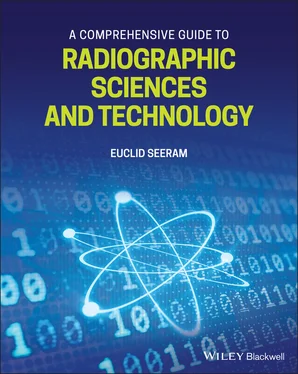A good example of the above is offered by the ASRT curriculum content which is organized around the following subject matter [1]: Introduction to Radiologic Science and Health Care; Ethics and Law in the Radiologic Sciences; Human Anatomy and Physiology; Pharmacology and Venipuncture; Imaging Equipment; Radiation Production and Characteristics; Principles of Exposure and Image Production; Digital Image Acquisition and Display; Image Analysis; Radiation Biology; Radiation Protection; Clinical Practice; Patient Care in Radiologic Sciences; Radiographic Procedures; Radiographic Pathology; Additional Modalities and Radiation Therapy; Basic Principles of Computed Tomography and Sectional Anatomy. Similar content is characteristic of other curricula offered by other medical imaging professional organizations around the world.
Keeping the above ideas in mind, this book will address content that are considered radiographic sciences and technology. Specifically, the chapters included present a summary of the critical knowledge base needed for effective and efficient imaging of the patient, and wise use of the technical factors that play a significant role in optimization of the dose to the patient without compromising the image quality necessary for diagnostic interpretation. Furthermore, the summaries of the technical elements of radiographic sciences and technology will assist the student in preparing to write certification examinations. As such, the major and significant principles and concepts will be reviewed in three sections as follows:
Section 1: Radiographic imaging systems: major modalities and components
Section 2: Radiographic physics and technology
Section 3: Radiation protection and dose optimization
RADIOGRAPHIC IMAGING SYSTEMS: MAJOR MODALITIES AND COMPONENTS
In this book, the following radiographic imaging systems will be reviewed. These include x‐ray imaging modalities such as digital radiography (DR) which includes CR and FPDR, DF, DM, digital radiographic and breast tomosynthesis, and CT. Furthermore, these systems include imaging informatics which has become commonplace since radiology and more importantly hospitals are now all operating in the digital environment; that is, all data acquired from the patient are now in digital form and are stored and communicated using digital technologies. Informatics topics of importance include that nature and scope of PACS, enterprise imaging, cloud computing, Big Data, and the more recent of computer applications in medical imaging: AI. More details of these major technologies and how they work will be presented in Chapter 6on Digital Imaging Modalities and Chapter 10on Imaging Informatics.
RADIOGRAPHIC PHYSICS AND TECHNOLOGY
Radiographic physics and technology subject matter include basic physics concepts, and more specifically the physics of diagnostic imaging; technical aspects of the modalities; radiographic exposure technique; image quality, quality assurance (QA), and QC; CT physical principles; imaging informatics; radiobiology and radiation protection.
Essential physics of diagnostic imaging
The physics of diagnostic imaging is an important and vital topic that explains the nature of how these imaging modalities work to produce diagnostic images of the patient. Understanding the fundamental physics will provide the user with the tools not only needed to produce optimum image quality but more importantly to protect the patient from unnecessary radiation. As such, it is now a common characteristic of imaging departments to optimize radiation dose and work within the International Commission on Radiological Protection (ICRP) philosophy of as low as reasonably achievable (ALARA) to reduce the dose to the patient but not compromise the diagnostic quality of the images used to make a diagnosis of the patient's medical condition.
In this book, the topics in physics that will emphasize the imaging modalities are the nature of radiation, x‐ray generation, x‐ray production, x‐ray emission, x‐ray attenuation, and x‐ray interaction with matter. Furthermore, other physics topics of significance are radiation quantities and their associated units and measurement concepts. These topics and more fall in the domain of Health Physics . Three radiation quantities that are important to radiation protection of the patient are exposure, absorbed dose, and effective dose (ED). The units associated with each of these include coulombs per kilogram (C/kg), Grays (Gy), and Sieverts (Sv), respectively. In order to measure radiation, it must first be detected.
Digital radiographic imaging modalities
As listed earlier in this chapter, these modalities include CR, FPDR or DR as it is sometimes referred to, DF, DM, digital radiographic tomosynthesis (DRT), digital breast tomosynthesis (DBT), and last but not least CT. Additionally, since all of the above‐mentioned modalities include image processing using computers, the concepts of Digital Image Processing will be reviewed since it has become an essential tool for technologists, radiologists, and medical physicists working in a digital radiology department.
These imaging modalities include specific physics concepts that must be understood for optimum results. For example, CR is based on the use of photostimulable phosphors (PSP) which are based on the physical principle of photostimulable luminescence (PSL). An example of one such phosphor is barium fluoro halide (BaFX) where the halide (X) can be chlorine (Cl), bromine (Br), iodine (I), or a mixture of them. When the PSP imaging plate (IP) is exposed to x‐rays, electrons are moved from the ground state (valence band) to a higher energy level (conducting band) and are trapped there until the PSP plate is exposed to a laser light and subsequently the electrons in the higher energy state return to their ground state, thus emitting a bluish‐purple light referred to as PSL.
The detectors used in FPDR are based on semiconductor physics. Examples of two such common detectors used in DR are indirect digital detectors which use amorphous silicon photoconductor coupled to an x‐ray scintillator (cesium iodide for example) and direct digital detectors which use amorphous selenium photoconductor. While the former detector converts x‐rays to light which falls upon the silicon photoconductor to produce electrical signals, the latter detector converts x‐rays directly into electrical signals. The other digital imaging modality detectors are based on photoconductor physics.
The imaging modalities listed above convert radiation attenuated by the patient and falling on the digital detector to digital data. This is necessary since computers are used to process these data through popular digital image processing operations. These operations have become commonplace and must be fully understood for effective use in clinical practice. One such tool is the concept of windowing, where the image brightness and contrast can be changed by the operator to suit the viewing needs of the human interpreter. Furthermore, other digital image processing tools that are vital in DBT and CT image reconstruction algorithms. These algorithms have evolved from the filtered back projection (FBP) algorithm to more complex algorithms such as iterative reconstruction (IR) algorithms. These algorithms play an important role in building up an image from data collected through 360° around the patient in CT, for example. Today, IR algorithms are now used by all CT vendors.
Radiographic exposure technique
Radiographic exposure technique refers to the use of exposure factors coupled with other elements on the x‐ray control panel, selected by the technologist to produce diagnostic images. Exposure factors include the kilovoltage (kV), the milliamperes (mA), and exposure time (s) and the selection of the appropriate source‐to‐image receptor distance (SID). Furthermore, the proper positioning of the patient and image receptor, tube alignment with the image receptor, use of appropriate filtration and collimation, and patient instructions, are all the other elements that play an important role during the radiographic examination.
Читать дальше











